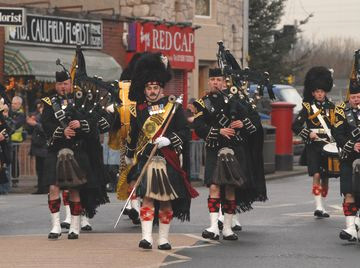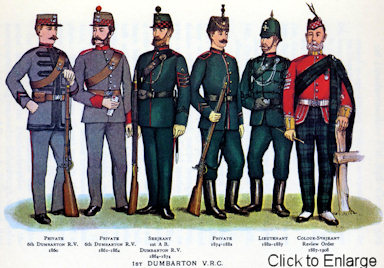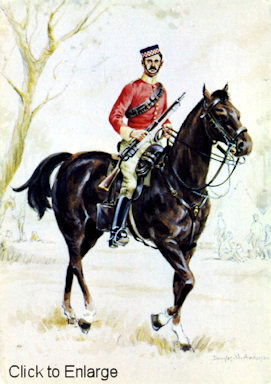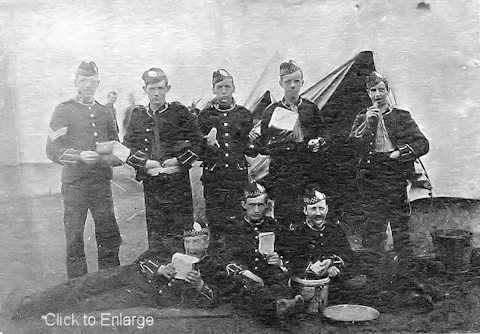Preface to the 9th Argylls and Dumbarton Volunteers
The web-site is delighted to be permitted by Mike Taylor to publish his brief history of the local fighting units in Dumbartonshire in the past 2 centuries and the men who served in them. Mike, who was the local authority’s Head Librarian, as well as a local historian of note, had the job of preparing this document thrust onto his lap at very short notice in 1982, when an Exhibition was put on in Dumbarton Library of the volunteer forces in the area. As you will agree, Mike did an excellent job.
The 9th Argylls and Dumbarton Volunteers
By Michael Taylor
1982
Introduction.
 The 9th Battalion of the Argyll and Sutherland Highlanders came into being in 1908, under the Territorial and Reserve Forces Act of 1907. A meeting summoned by Lord Overtoun, the Lord Lieutenant of the County of Dumbartonshire, had been held in the County Council Chambers in Dumbarton in December of the previous year. At that meeting the Dumbartonshire Territorial Force County Association (“DTFCA”) was set up to administer but not command the new Battalion. The new force came under War Office Control.
The 9th Battalion of the Argyll and Sutherland Highlanders came into being in 1908, under the Territorial and Reserve Forces Act of 1907. A meeting summoned by Lord Overtoun, the Lord Lieutenant of the County of Dumbartonshire, had been held in the County Council Chambers in Dumbarton in December of the previous year. At that meeting the Dumbartonshire Territorial Force County Association (“DTFCA”) was set up to administer but not command the new Battalion. The new force came under War Office Control.
The 9th was one of five Territorial Battalions which formed part of the Argyll & Sutherland Highlanders Regiment at that time. The Regiment itself had been created in 1881, as part of the Cardwell Reforms of the British Army, by amalgamating the 91st Argyllshire and 93rd Sutherland Highlanders. The Territorial Battalions were intended for home service only, but members of the Territorial Forces could volunteer for service outside the country, although they were voluntary, part-time soldiers.
The Roots of the 9th Battalion
 The roots of the Territorials go back much further than that. In 1793 the Wars against Revolutionary France which developed into the Napoleonic Wars, had prompted the government to create local voluntary forces for defence of the British homeland. Locally 1793 saw the formation of the Dumbartonshire Fencibles and the Dumbartonshire Fencible Cavalry, as well as a local militia.
The roots of the Territorials go back much further than that. In 1793 the Wars against Revolutionary France which developed into the Napoleonic Wars, had prompted the government to create local voluntary forces for defence of the British homeland. Locally 1793 saw the formation of the Dumbartonshire Fencibles and the Dumbartonshire Fencible Cavalry, as well as a local militia.
In 1859 the threat of another war with France led to the creation of local volunteer forces under the direction of the War Office. 7th May 1860 saw the formation of the Dumbartonshire Rifle Volunteers (the “DRV”), who had their first head-quarters at Balloch. Initially the Battalion consisted of 10 companies including at Bonhill, Jamestown Alexandria, Luss but neither Renton nor Kilmaronock. Later 4 additional companies were raised including one at Tarbet.
The uniform was originally slate-grey, but in 1864 it was changed to rifle-green with scarlet collars and piping.
On 28th April 1880 the Battalion was consolidated under the title 1st Dumbartonshire Rifle Volunteer Corps (“DRVC”) with its head-quarters in Helensburgh.
The Cardwell Reforms
 The 1881 Cardwell Reforms brought sweeping changes in the British Army, part of which was linking the county volunteers to a regular regiment of the line. Thus the 1st Dumbartonshire Rifle Volunteer Corps became attached to Princess Louise’s (Argyll and Sutherland Highlanders). The Battalion was entitled to wear the uniform and badges of the regiment, although it insisted in retaining the Elephant and Castle emblem in the Argyll badge.
The 1881 Cardwell Reforms brought sweeping changes in the British Army, part of which was linking the county volunteers to a regular regiment of the line. Thus the 1st Dumbartonshire Rifle Volunteer Corps became attached to Princess Louise’s (Argyll and Sutherland Highlanders). The Battalion was entitled to wear the uniform and badges of the regiment, although it insisted in retaining the Elephant and Castle emblem in the Argyll badge.
The years 1881-1908 saw a marked improvement in the organisation, training and equipment of the local volunteers as the government attempted to increase the fighting value of these forces. Funding in the form of grants to the units was considerably improved as well as the financial position of the volunteers.
The Boer War
In 1900 the 1st DRVC sent their quota of volunteers to the 3 Volunteer Active Service Companies of the Argyll and Sutherland Highlanders fighting in South Africa. After the war 13 men from the local Volunteers were granted the Freedom of Dumbarton in recognition of their service in the South African campaign.
The Boer War at least proved that the volunteer forces were capable of playing their part in the field of battle. As a result the DVRC saw not only increased strength but also increased efficiency. By 1905 Battalion strength was 50 officers and 1,271 other ranks in the 14 companies which made up the Battalion.
The Haldane Army Reforms and the Creation of the Territorial Forces (the “TF”)
In 1907 there was another re-organisation of the Army. These reforms were prompted by the Army’s failures in the Boer War and were known as the Haldane Reforms after Richard Haldane who was the Liberal Secretary of State for War 1905 – 1912 and who was responsible for drawing up the reforms. A prime objective was the proper utilisation of the volunteer forces. The various volunteer forces throughout the UK were disbanded and absorbed into new Territorial Force battalions. The 1st Dumbartonshire Rifle Volunteer Corps had held a prominent place in the county and earned itself a high reputation amongst the other volunteer battalions. It was a unit in which all classes from the highest to the lowest had mixed in service to the country.
Creation of the 9th Battalion Argyll & Sutherland Highlanders
1st April 1908, the DRVC relegated 17 officers to the supernumerary list and struck 640 other ranks off the strength and went into the new Territorial Force with 29 officers and 840 men.
The 9th (Dumbartonshire) Battalion Princess Louise’s (Argyll & Sutherland Highlanders) came into being, in which the kilt, hose and sporran took the place of trews. The Battalion strength was to be 8 companies, distributed thus:
| A Company | Helensburgh |
| B Company | Kirkintilloch |
| C Company | Dumbarton |
| D Company | Milngavie |
| E Company | Bonhill and Jamestown |
| F Company | Alexandria and Renton |
| G Company | Clydebank |
| H Company | Yoker |
 Great efforts were made to stimulate recruitment helped by eminent people such as the Duke of Argyll speaking at public meetings in support of the new Battalion throughout the county. Colonel Henry Brock, the last commanding officer of the 1st DRVC and the first of the new 9th did much to persuade his former colleagues to enlist in the new battalion. By January 1909 the Ninth had reached 90% of its required establishment.
Great efforts were made to stimulate recruitment helped by eminent people such as the Duke of Argyll speaking at public meetings in support of the new Battalion throughout the county. Colonel Henry Brock, the last commanding officer of the 1st DRVC and the first of the new 9th did much to persuade his former colleagues to enlist in the new battalion. By January 1909 the Ninth had reached 90% of its required establishment.
New colours, paid for by Lady Inverclyde wife of the Lord Lieutenant, were presented by HRH Princess Louise, Colonel-in-Chief of the Regiment, in the grounds of Ardencaple House. Two years later these colours were brought back to Dumbarton and placed in the County Council buildings.
In 1909 Colonel Brock retired from active duty and was succeeded as Commanding Officer (“CO”) by Colonel Sir Alexander Wellesley Leith Buchanan of Ross Priory.
In 1911 the head-quarters of the County Territorials moved from Helensburgh to Dumbarton where the former mansion house of Hartfield was taken over.
The First World War
The declaration of war in 1914 found the local TF at camp in Kintyre. The Battalion assembled at Dumbarton and many were billeted in local schools. On the morning of Tuesday 11th August the Battalion mustered on the Common before leaving for Bedford by train. The men took with them a number of carts and repainted them in military colours, as well as some horses which they had commandeered in the district. The CO, Colonel Leith-Buchanan was not passed fit for service overseas and was replaced by Lt Colonel James Clark.
In October 1914 a second unit of the Ninth was formed and it was named the 9th (Reserve) Battalion Argyll and Sutherland Highlanders (TF). Colonel Sir Alexander Leith-Buchanan was appointed its CO, while several officers at Bedford with the front line Battalion were sent back from Bedford to join the unit. Later this Reserve force was renamed the 2/9th Battalion Princess Louise’s (Argyll & Sutherland Highlanders) TF, and acted as a unit on coastal defence as well as producing drafts for the Army in France.
In 1915 a 3rd line depot of the 9th Argylls was raised, designed to train recruits and to act as a depot for men discharged from hospital.
Meanwhile the 1/9th were being trained and equipped in preparation for their departure to France. On the night of 19/20th February 1915 the Battalion sailed to Le Harve and was soon engaged in the Ypres Salient, attached to the 81st Brigade, 27th Division. On 10th March 1915 the Battalion took its first casualties, with 5 men wounded. 10 days later a Corporal MacKay became the first 9th Argyll to be killed in action. For the first two months of their posting in Ypres the 9th’s casualties were relatively light, it was their turn to suffer.
May 1915 – The Carnage Inflicted on the Battalion at Ypres
From the 10th to the 17/18 May 1915 the Battalion took part in fierce fighting and had to bear heavy German bombardment. On the 10th of May itself the Battalion losses amounted to 12 officers and 300 men, including the CO Colonel Clark. Sadly the losses continued to mount. A terrible gas attack which was launched by the Germans on 24th May all but overwhelmed the men, who had been ordered forward to support the Royal Dublin Fusiliers. When the Battalion was formally withdrawn from the front that day its strength mustered just 2 officers and 85 men.
Tragedy haunted the Battalion even at home. Captain Findlay and Lieutenants Jackson, Kirsop and Bonnar left the front for a spot of leave that same month of May. Two days after their departure 3 of them were killed in the train disaster near Gretna.
By the end of the terrible month of May 1915 the 1/9 were instructed to amalgamate with the 7th Battalion, who had also suffered heavy losses, under the title “The Composite Battalion of the Argyll & Sutherland Highlanders”. The amalgamation was intended as a temporary measure and would exist until such times as reinforcements could come from 2/9th Battalion. Six months after the terrible losses of May 1915, the Battalion had been brought up to a strength of 25 Officers and 461 other ranks.
But the Battalion could not be brought up to its required strength. Because of the great demands of industry in the county, the problem of obtaining new recruits in Dumbartonshire was apparent to all. Eventually the Battalion had to be disbanded. Everything was done to preserve the local identity of the Dumbartonshire Territorials but sentimental feelings could not be allowed to stand in the way of the efficiency of the Army as a whole.
The Battalion no longer existed but the Officers and Men of the 1/9th continued to serve in other battalions and other regiments. In its short time in France it was mentioned in dispatches 3 times and personally complimented by Field Marshall Sir John French. By July 1917 the 2/9th and the 3/9th ceased to exist as well.
Between the Wars
When peace came the DTFA could remind the War Office of the pledge to reconstitute the Battalion at the cessation of hostilities. In April 1919 it was announced that a cadre of the Battalion was to be formed and that it would form the nucleus of the reconstituted 9th Battalion. At the same time the War Office decided to re-organize the Territorial Forces under the new title of Territorial Army and a new Commanding Officer was appointed to the 9th Battalion, Lt Colonel D McGhee.
The early 1920’s saw a gradual strengthening of the old Battalion. A new drill hall was opened in Latta Street in 1923 and in July 1926 an event of some historical importance took place. Over several years various attempts had been made to persuade the Office of Works to allow the Territorials to use Dumbarton Castle as its head-Quarters. In 1925 the request was granted and the Battalion marched from the Drill Hall in Latta Street to the Castle and officially took it over. The occasion was the first time that the town of Dumbarton had seen the new reformed 9th Battalion. The “occupation” of the Castle lasted until 1939 when war broke out again.
The local Battalion ceased to be an infantry battalion in November 1938 when it became the 54th Light Anti-Aircraft Regiment of the Royal Artillery. It consisted of:
160 Battery (Dumbarton)
161 Battery (Alexandria) and
162 Battery (Helensburgh).
The reorganised force was still part of the Field Army and not part of the Home Defence Forces. This further reorganisation of the Territorials resulted in B Company (Kirkintilloch) and D Company (Clydebank) going to form a 2nd line regiment with the 58th Light Anti-Aircraft Regiment.
The Second World War
The Second World War broke out on 3rd September 1939, and on the 25th September 1939 the 54th embarked for France. The next few months in France were spent guarding installations and continuing their training. Equipment was in short supply at first, there being only 12 Bofors guns in the whole Regiment – enough to equip only one out of the three batteries.
In December 1939 162 Battery was moved on to Boulogne. This separation lasted until May 1940 and the fall of France.
On the morning of 16th May 1940 all the guns of 160 and 161 Batteries were in action against German aircraft. By now the 54th were giving protection to various types of vital installations; airfields, power stations etc as well as covering infantry units awaiting the German attack. There was plenty of action against enemy aircraft that month of May and the regiment suffered its first casualties as the Battle of France grew.
Incredibly, after only a few months of battle, the order came to withdraw the Regiment to Dunkirk. All vehicles and kit were to be abandoned at the perimeter of the town and only guns and small arms were taken into the defended area. The Bofors were moved onto the beach and employed against the numerous attacks by enemy aircraft. On the 1st June the order came through for the men of 160 and 161 Batteries to be taken off the beach and shipped back to Britain.
In the meantime, 162 Battery was employed in the protection of the airfields around Rheims. As the Germans threatened, various withdrawals were made to-wards the coast. When the Italians entered the war, support for the RAF in the south of France was stepped up. To help this support, a troop from 162 Battery was moved to Marseilles, thereby carrying out the largest approach march made by any sub-unit of the regiment in the entire war. By mid-June both these sections of 162 had been embarked for the homeland.
The years 1940 – 1944 were spent re-equipping and training, participating in exercises and manoeuvres as well as helping to defend the country from the German airforce. In May 1943 the pipes and drums of the old 9th were collected from Dumbarton Castle and the 54th reverted to the Tam O’ Shanter bonnet and the Argyll badge.
The 54th Light Anti-Aircraft Regiment was not chosen to cross with the main assault forces on D-Day, but had to be content to be part of the build-up force. The Canadian Army had requested an additional Light Anti-Aircraft Regiment and they got the 54th. Following the landing in Normandy, the Regiment served in Northern France, Belgium, the Netherlands and eventually Germany itself after the surrender of the German forces.
Immediate Post-Second World War
It was announced in January 1946 that the 54th Light Anti-Aircraft Regiment would go into “suspended animation”. It would exist on paper but could be re-formed at any time in the future.
Twelve months later, another re-organisation of the TA took place which resulted in new units for the County:
- The 554th Light Anti-Aircraft Regiment (A & SH) RA
- 417 Coast regiment (RA)
- 254th Anti-Tank Regiment (RA)
The End of the 9th Battalion
In 1955 the story of the Ninth Battalion came to an end as the last elements were transferred to the 8th Battalion of the Argyll & Sutherland Highlanders and to the 402.
The Ninth battalion were proud successors of the old Volunteer Force and even after the Ninth “officially” disappeared at the re-organisation of 1938, the men still considered themselves Argylls. The hope that the Battalion would be reconstituted as an infantry battalion never materialised, but the memory of the gallant Ninth lives on and Dumbartonshire can be proud of its volunteers who served their county and their country so well.


